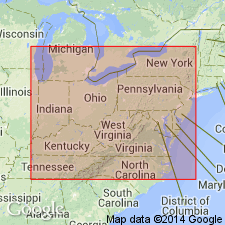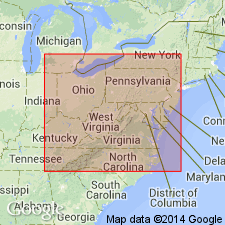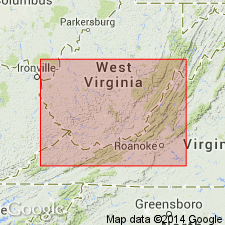
- Usage in publication:
-
- Cleveland Member, Bed*
- Modifications:
-
- Revised
- Areal extent
- AAPG geologic province:
-
- Appalachian basin
Summary:
Cleveland Member of the Ohio Shale extended from OH and eastern KY into westernmost WV, western VA, and a small portion of northern TN. Reduced in rank to Cleveland Bed of Gassaway Member of Chattanooga Shale in areas where Ohio Shale is not recognized; extended to central TN, northeastern AL, and northwestern GA.
Source: GNU records (USGS DDS-6; Reston GNULEX).

- Usage in publication:
-
- Cleveland Member*, Bed*
- Modifications:
-
- Overview
- AAPG geologic province:
-
- Appalachian basin
Summary:
In northern OH, Ohio Shale includes two sequences of black shale, the Huron Member below and the Cleveland Member above. A tongue of Chagrin Shale separates the Huron from the Cleveland in northern and eastern OH. In outcrops in central and southern OH and much of northeastern and central KY, the Three Lick Bed of the Ohio Shale, (a featheredge of the Chagrin Shale) separates the two members. In southern KY and central TN, the Huron and Cleveland are present as beds in the Gassaway Member of the Chattanooga Shale. The Huron is thicker and more extensive than the Cleveland. In northwestern PA and adjacent western NY, the Huron becomes the Dunkirk Shale Member of the Perrysburg.
Source: GNU records (USGS DDS-6; Reston GNULEX).

- Usage in publication:
-
- Cleveland Shale Member
- Modifications:
-
- Areal extent
- Revised
- AAPG geologic province:
-
- Appalachian basin
Summary:
Cross section between Norton and Asberrys, southwestern VA, in the Clinch Mountain outcrop belt shows more detailed divisions of Chattanooga Shale than previously indicated. Base of Chattanooga marked by Belpre Ash. Ascending, members are Rhinestreet Shale, Angola Shale, Java Shale (including the Center Hill Ash), Dunkirk Shale Tongue of Huron Shale Member and remaining upper part of Huron, Three Lick Bed, Cleveland Shale Member, and Sunbury Shale Member. According to authors, divisions are based on careful outcrop description and outcrop gamma-ray log. Divisions can be traced by borehole gamma-ray logs to their type areas in OH and NY.
Source: GNU records (USGS DDS-6; Reston GNULEX).
For more information, please contact Nancy Stamm, Geologic Names Committee Secretary.
Asterisk (*) indicates published by U.S. Geological Survey authors.
"No current usage" (†) implies that a name has been abandoned or has fallen into disuse. Former usage and, if known, replacement name given in parentheses ( ).
Slash (/) indicates name conflicts with nomenclatural guidelines (CSN, 1933; ACSN, 1961, 1970; NACSN, 1983, 2005, 2021). May be explained within brackets ([ ]).

